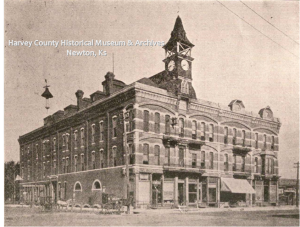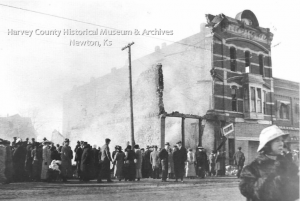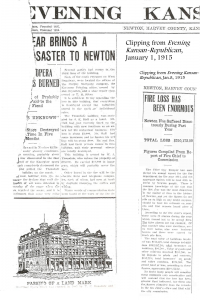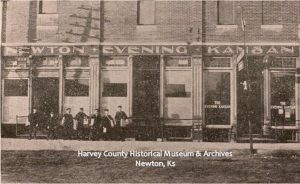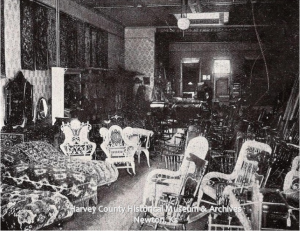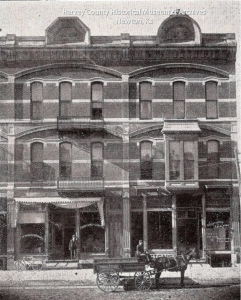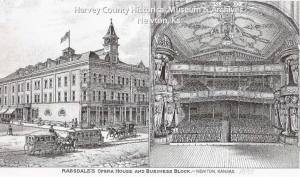by Kristine Schmucker, HCHM Curator
Early Morning, New Year’s Day, January 1, 1915.
Early in the morning on New Year’s Day in 1915, Hal Somers and Mary Russell, ran out of gas on their way home from the Knights Templar Ball and New Year’s Eve lunch at George Glenn’s. As a result, they were walking through town at about 2:30 am. They had reached Broadway and Main, when they noticed a light coming from the back of the otherwise dark opera house. They “soon discovered a blaze coming out of the back door in the second story.” They ran to a nearby home and sounded the alarm.
“In a remarkably short time the rear of the building was ablaze all over, and by the time the fire department reached the scene it had gained considerable headway.”
While the firefighters worked to get the fire under control and keep it from spreading to neighboring buildings, other volunteers tried to save what they could, carrying out valuables and merchandise.
The Newton Journal described the scene.
“In less than an hour the flames licked up the offices and shops at the west end and swept through the McManus dry goods and clothing store at the front of the building and the south wall and belfry were down.”
The Weekly Kansan Republican noted the loss of the clock, 45 minutes after the fire was discovered.
“The last time the old town clock struck the hour was at the third hour of the New Year, and at fifteen minutes after three the hands of the clock dropped from sight.”
By daylight, the entire building, a landmark since 1885, was gone.
30 Years Earlier, Spring 1884
Two brothers, James M. and Thaddeus P. Ragsdale, decided to invest in the future of Newton, Ks. Already successful businessmen, the brothers sold their grocery business in 1879 and began “dealing in real estate.” Using their own money, they bought lots, built homes or businesses and sold the improved property. They added over one hundred houses and seven business blocks to Newton. (Fent, p. 24) In 1884, they turned their attention to their largest project, building an opera house at the corner of Broadway and Main.
It took a year and a half to construct the Ragsdale Opera House beginning in May 1884 and completed in 1885. The massive three story structure covered three lots at 701 Main. Although the exterior had brick and stone, the interior was entirely wooden. The brothers paid $8,000 for the lots and the nearly completed structure cost eighty thousand dollars.
The ground floor consisted of businesses, including the Newton Kansan. Phil H. Knowlton, editor of the Daily and Weekly Kansan (1896-1898) recalled that “it was in the basement of this historic building that I began my newspaper career” after graduating from Newton High.
Other businesses included Schumacher’s Furniture.
The east section of the structure had eight rooms each on the second and third floors with several used for apartments. A winding staircase led to an observatory and a three faced Seth Thomas Clock. The six hundred dollar clock was paid for by donations from the community. The clock had a six foot dial and a six hundred pound bell which, some claimed, could be heard from two miles away on a clear day.
The Post Office was located in a space along Main Street until 1912 and for some of that time tickets to performances were available.
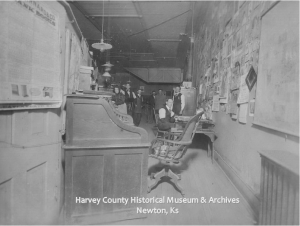
Post Office in the Ragsdale Opera House, 1903. Man on the left is Guy Sawyer and the far right is Charles Benfer.
The actual theater was located at the west end on the second and third floors.
The main entrance to the actual theater was on Broadway and was marked with a semi-circular sign “Ragsdale Opera House.” This was the only indication that it was an opera house on the exterior. From a small lobby, patrons would go up the main stairway, which was constructed of oak and “gracefully curved up up to the main theatre lobby.” There was a smaller secondary staircase from the Main Street entrance. The house itself had three levels and seated eight hundred in addition to eight private boxes which could seat five each. The ceiling had ornate frescoes and the walls and woodwork were painted a dark red. Over the next several years, the interior would be repaired, cleaned, and repainted several times. The last improvement to the theater was made in 1911-12, when it was again cleaned and the drop curtain repainted.
In a remembrance column for the 50th Anniversary of the Newton Kansan, Knowlton described the Opera House “as the town’s pride and joy-parquet, balcony . . . ‘neverything.
Gas lights were furnished by a Hagen & DeWitt gas machine in the basement. And the boxes! Varied-colored rosettes, fringes, draperies and gingerbread stand out in my memory as a creation worthy of a patch-quilt super-artist!”
The Ragsdale brothers lost possession of the opera house on 11 August 1892, as a result of the financial panic of 1890 which was particularly hard on those who had invested in real estate. Despite several new owners, the building continued to be known as the Ragsdale until November 1907. The new owner had the name plate obliterated and replaced with the name “Knoepker Opera House.” At about the same time, changes were made to comply with the latest fire regulations.
By 1910, the building was showing its age and deteriorating from general neglect. At that time, the possibility of constructing a new opera house was briefly discussed. However, nothing ever came of the discussions.
For thirty years, the Opera House was a Newton landmark, home to several businesses and the main center for entertainment.
On that early New Year’s Day morning, the community lost more than an aging building. One life was lost, several businesses lost everything and a unique historical landmark was gone. The cause of the fire was believed to be broken gas pipes in the southwest room of the stage. However, local residents claimed that a “distinctive odor of oil was detected in the vicinity of the stage” causing many to suspect arson. The actual cause of the fire was never verified.
Part 2: The fate of Willis T. Green, who was living in rooms at the opera house, was not known until a day later. His story will be the focus of our next post.
Part 3: Several businesses also lost a great deal. For one man, T.H. McManus, it was the second time he was forced to rebuild after a fire destroyed his business. Part 3 of our series on the Ragsdale Fire will conclude with stories of various businesses that were affected.
Sources:
- Newton Republican, 11 December 1885.
- Newton Kansan, 12 November 1885.
- Evening Kansan Republican, 1 January 1915,
- Newton Journal 8 January 1915.
- Early Fire Protection In Newton, Kansas, 1872-1922.
- Newton Kansan 50th Anniversary, 22 August 1922.
- Fent, Mary Jeanine. Ragsdale Opera House — Newton, Kansas, 1885-1915. MA Thesis, University of North Carolina at Chapel Hill, 1977. HCHM Archives.
- HCHM Photo Archives

